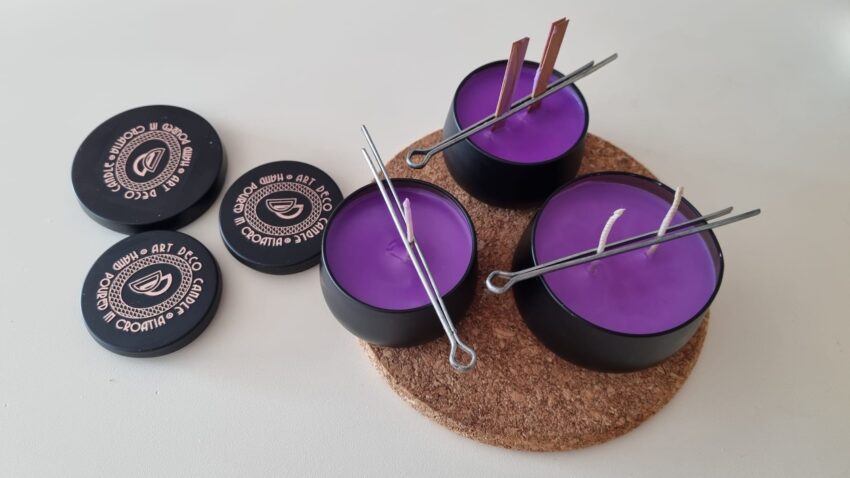Christmas season is fast approaching, and it’s time to find the perfect gift for family and close ones or for business partners. A candle could be a great present, right?
There are always generic candles available, mass-produced by well-known companies, which will be entirely adequate for someone whose tastes you don’t know well. With a bit more effort, you can find a candle suited to the taste of the person you’re buying it for – a candle that will delight with its appearance, fragrance notes, and the quality of the materials it’s made of. You can buy candles from branded manufacturers in specialized shops or online stores. Also, year by year, more and more candles are handcrafted by small businesses in limited quantities.
A candle truly can be an ideal gift.
Most people are satisfied with an affordable price of the candle and it’s nice scent. Few people consider the quality of the candle they plan to light in their homes. I won’t discuss the use of fragrance and essential oils in candles here; that’s a topic on its own.
Soy wax candles are becoming an increasingly popular option among those who don’t want to buy paraffin candles. They are marketed as a “natural” alternative to paraffin candles, but this is misleading. While soy as a plant is natural, soy wax is not. It is produced by subjecting soybean oil to hydrogenation, which is a common method for producing plant-based waxes.
However, it’s important to consider that soy is not native to Europe. It originates from East Asia, although it is now grown worldwide due to its nutritional properties. Soy thrives best in temperate, subtropical, and tropical regions. In colder areas, growing soy is more challenging and yields are lower; therefore, countries like the US genetically modify soy to thrive in cooler climates. The European Union has strict regulations on genetically modified crops. Essentially, EU allows the import of GMO soy but not its cultivation within the EU. Out of non-GMO soy grown on EU soil the most soy is grown in Italy.
It’s crucial to note that the European Union does not produce enough soy to meet all its needs. Most of this demand is for animal feed, with only a small portion processed into oil, and some of that oil then processed into wax. Despite ongoing yield increases, the EU produces at best one-third of its total soy needs, with the remainder imported from Brazil, the US, Ukraine, and other countries.
Yes, stop and think about it for a moment. The European Union relies on other countries to supply its annual soy needs!
This raises other questions, which may not be easy to digest (pun intended).
What would you say if I asked you whether soy production contributes to environmental pollution?
If your answer is “No! No chance in Hell!” I’m sorry to disappoint you.
In Brazil, the world’s largest soy producer, deforestation has been documented, particularly in the Amazon region, as well as a decrease in biodiversity due to increased soy planting. Authorities have recognized the potential threat and banned deforestation for soy cultivation. The result? Deforestation continued but not for soy planting – now it’s for livestock grazing. The rising demand for soy now indirectly drives Amazon deforestation. Farmers have simply replaced sections of the Amazon (affectionately called the “Lungs of the Planet”) with pastures to accommodate livestock relocated from areas now planted with soy. The fact that this contributes to climate change seems, in the scale of global soy trade, to be a negligible footnote.

The international transport of this crop to the EU increases greenhouse gas emissions, further warming the planet. Some soy wax producers specifically state that only non-GMO soy grown in the EU was used to make the wax. However, given that the EU does not produce enough soy, it’s questionable whether it can now, or in the near future, produce enough soy wax from locally grown plants to meet the market’s ever-growing candle demand for soy wax.
There are also other plant-based waxes that have a smaller environmental impact because they’re produced in the EU from plants that don’t require special treatments for high yields. Rapeseed wax is one of these new types of wax, with rapeseed being native to Europe. I personally use rapeseed wax in the candles I make. This wax is much harder than soy wax. I’ve also noticed that candles made from rapeseed wax release a stronger fragrance and burn a bit longer than those made identically from soy wax with the same fragrance oil percentage.
Today, ecological, renewable, and completely natural products are particularly valued. However, the mere fact that a product is advertised as such does not automatically mean that it contributes to conservation of nature. Nor dos it means that it is the only option for producing items that are safe for the health of people and our pets.
